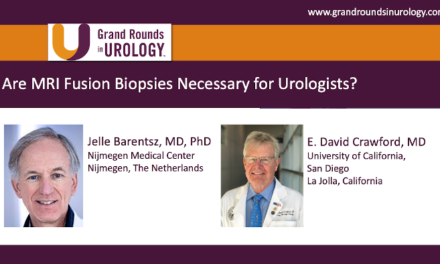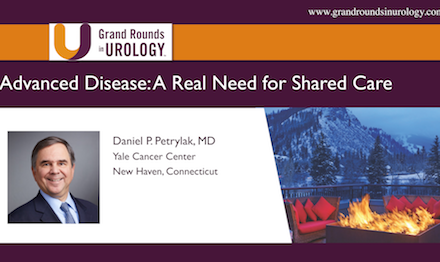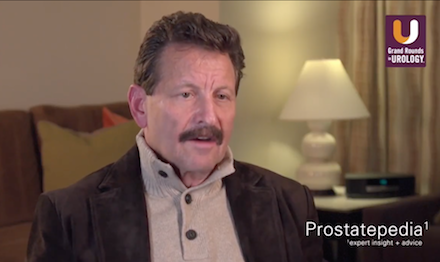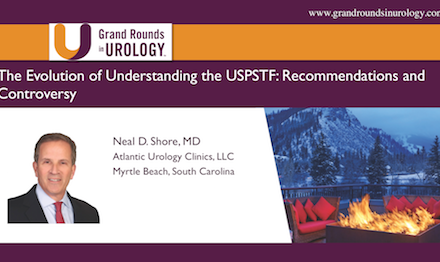Dr. Erik P. Castle spoke at the 23rd annual Perspectives in Urology Point • Counterpoint meeting on Saturday, November 15, 2014 on “Novel Secondary Hormonal Therapies for Prostate Cancer.”
Keywords: novel secondary hormonal therapies, prostate cancer
How to cite: Castle, Erik P. “Novel Secondary Hormonal Therapies for Prostate Cancer” Grand Rounds in Urology. August 13, 2015. Accessed Nov 2024. https://dev.grandroundsinurology.com/prostate-cancer-erik-p-castle-novel-secondary-hormonal-therapies-for-prostate-cancer/.
References
Bosland MC, Ford H, Horton L. Induction at high incidence of ductal prostate adenocarcinomas in NBL/Cr and Sprague-Dawley Hsd:SD rats treated with a combination of testosterone and estradiol-17 beta or diethylstilbestrol. Carcinogenesis. 1995 Jun;16(6):1311-7.
http://www.ncbi.nlm.nih.gov/pubmed/7788848
Chan PS, Chan LW, Xuan JW, et al. In situ hybridization study of PSP94 (prostatic secretory protein of 94 amino acids) expression in human prostates. Prostate. 1999 Oct 1;41(2):99-109.
http://www.ncbi.nlm.nih.gov/pubmed/10477906
Debes JD, Tindall DJ. Mechanisms of androgen-refractory prostate cancer. N Engl J Med. 2004 Oct 7;351(15):1488-90.
http://www.ncbi.nlm.nih.gov/pubmed/15470210
de Jong FH, Oishi K, Hayes RB, et al. Peripheral hormone levels in controls and patients with prostatic cancer or benign prostatic hyperplasia: results from the Dutch-Japanese case-control study. Cancer Res. 1991 Jul 1;51(13):3445-50.
http://www.ncbi.nlm.nih.gov/pubmed/1711411
Fowler KA, Gill K, Kirma N, et al. Overexpression of aromatase leads to development of testicular leydig cell tumors : an in vivo model for hormone-mediated TesticularCancer. Am J Pathol. 2000 Jan;156(1):347-53.
http://www.ncbi.nlm.nih.gov/pubmed/10623684
Ghatak S, Ho SM. Age-related changes in the activities of antioxidant enzymes and lipid peroxidation status in ventral and dorsolateral prostate lobes of noble rats. Biochem Biophys Res Commun. 1996 May 15;222(2):362-7.
http://www.ncbi.nlm.nih.gov/pubmed/8670210
Gleave M, Evans CP. What’s hot in the prostate? Prostate Cancer Prostatic Dis. 2004;7(4):273-6.
http://www.ncbi.nlm.nih.gov/pubmed/15592439
Hewitt SC, Harrell JC, Korach KS. Lessons in estrogen biology from knockout and transgenic animals. Annu Rev Physiol. 2005;67:285-308.
http://www.ncbi.nlm.nih.gov/pubmed/15709960
Ho SM, Leav I, Ghatak S, et al. Lack of association between enhanced TRPM-2/clusterin expression and increased apoptotic activity in sex-hormone-induced prostatic dysplasia of the Noble rat. Am J Pathol. 1998 Jul;153(1):131-9.
http://www.ncbi.nlm.nih.gov/pubmed/9665473
Kaplan PJ, Leav I, Greenwood J, et al. Involvement of transforming growth factor alpha (TGFalpha) and epidermal growth factor receptor (EGFR) in sex hormone-induced prostatic dysplasia and the growth of an androgen-independent transplantable carcinoma of the prostate. Carcinogenesis. 1996 Dec;17(12):2571-9.
http://www.ncbi.nlm.nih.gov/pubmed/9006091
Lam JS, Leppert JT, Vemulapalli SN, et al. Secondary hormonal therapy for advanced prostate cancer. J Urol. 2006 Jan;175(1):27-34.
http://www.ncbi.nlm.nih.gov/pubmed/16406864
Li L, Seno M, Yamada H, Kojima I. Promotion of beta-cell regeneration by betacellulin in ninety percent-pancreatectomized rats. Endocrinology. 2001 Dec;142(12):5379-85.
http://www.ncbi.nlm.nih.gov/pubmed/11713238
McPherson SJ, Wang H, Jones ME, et al. Elevated androgens and prolactin in aromatase-deficient mice cause enlargement, but not malignancy, of the prostate gland. Endocrinology. 2001 Jun;142(6):2458-67.
http://www.ncbi.nlm.nih.gov/pubmed/11356695
Migliaccio A, Castoria G, Di Domenico M, et al. Crosstalk between EGFR and extranuclear steroid receptors. Ann N Y Acad Sci. 2006 Nov;1089:194-200.
http://www.ncbi.nlm.nih.gov/pubmed/17261767
Montano MM, Deng H, Liu M, et al. Transcriptional regulation by the estrogen receptor of antioxidative stress enzymes and its functional implications. Oncogene. 2004 Apr 1;23(14):2442-53.
http://www.ncbi.nlm.nih.gov/pubmed/14676828
Ross R, Bernstein L, Judd H, et al. Serum testosterone levels in healthy young black and white men. J Natl Cancer Inst. 1986 Jan;76(1):45-8.
http://www.ncbi.nlm.nih.gov/pubmed/3455741
Signoretti S, Loda M. Estrogen receptor beta in prostate cancer: brake pedal or accelerator? Am J Pathol. 2001 Jul;159(1):13-6.
http://www.ncbi.nlm.nih.gov/pubmed/11438447
Tam NN, Gao Y, Leung YK, Ho SM. Androgenic regulation of oxidative stress in the rat prostate: involvement of NAD(P)H oxidases and antioxidant defense machinery during prostatic involution and regrowth. Am J Pathol. 2003 Dec;163(6):2513-22.
http://www.ncbi.nlm.nih.gov/pubmed/14633623
Yu M, Cates J, Leav I, Ho SM. Heterogeneity of [3H]estradiol binding sites in the rat prostate: properties and distribution of type I and type II sites. J Steroid Biochem. 1989 Sep;33(3):449-57.
http://www.ncbi.nlm.nih.gov/pubmed/2779236
ABOUT THE AUTHOR
Dr. Erik P. Castle is a Professor of Urology at the Mayo Clinic College of Medicine. His surgical expertise includes minimally invasive urologic oncology, including robot-assisted radical cystectomy, prostatectomy, retroperitoneal lymph node dissection, and partial nephrectomy. He has demonstrated many of these procedures internationally, as he pioneered robot cystectomy as well as robot RPLND. He directs the International Laparoscopic Nephrectomy Program in Mexico on behalf of the American Urologic Association (AUA), and also serves on several committees and guideline panels within the American Urologic Association. He is on the Early Detection of Prostate Cancer Panel for the National Comprehensive Cancer Network (NCCN) as well.
Dr. Castle’s research interests include prostate cancer, bladder cancer, and kidney cancer. He is the Director of the Desert Mountain Care Prostate Cancer Research Fund and is the principal investigator of his lab housed at the Mayo Clinic Collaborative Research Building. His basic science research is focused on novel secondary hormonal therapies of prostate cancer and apoptotic pathways related to manipulations of the androgen and estrogen receptors. He also directs the prospectively collected genitourinary biorepository at Mayo Clinic Arizona, which houses over 40,000 specimens.





